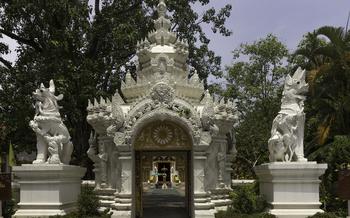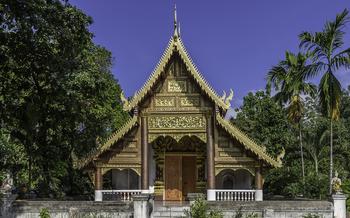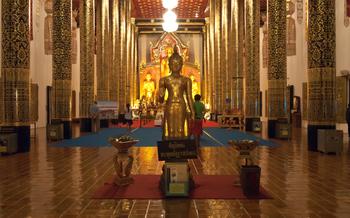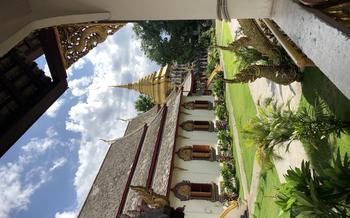
Tha Pai Hot Spring
- Tha Pai Hot Springs: An Oasis in the Mountains
- How to Get to Tha Pai Hot Springs
- Best Time to Visit Tha Pai Hot Springs
- What to Bring to Tha Pai Hot Springs
- Soaking in the Hot Springs
- Exploring the Surrounding Area
- Accommodation Options Near Tha Pai Hot Springs
- Dining Options Near Tha Pai Hot Springs
- Budget Considerations
- Planning Your Itinerary
- Safety Tips
- Cultural Insights
- Responsible Tourism
- Travel Tips for First-Timers
- Insider Tip: Off-the-Beaten-Path Gems
Tha Pai Hot Springs: An Oasis in the Mountains
Nestled amidst the lush greenery of Mae Hong Son Province in northern Thailand, the Tha Pai Hot Springs offer a tranquil retreat for weary travelers and nature enthusiasts alike. These natural hot springs, renowned for their therapeutic properties, are located in the rural district of Tha Pai, approximately 100 kilometers from the provincial capital.
The hot springs have a rich history dating back centuries, with local legends recounting tales of their healing powers. According to folklore, the springs were discovered by a wandering monk who stumbled upon them while seeking respite from a long journey. Impressed by the rejuvenating effects of the mineral-rich waters, he spread the word about their therapeutic properties, attracting pilgrims and visitors from far and wide.
Over time, the hot springs gained a reputation for their ability to alleviate various ailments, including rheumatism, muscle pain, and skin conditions. The natural spring water, rich in minerals such as sulfur, calcium, and magnesium, is believed to possess therapeutic properties that promote relaxation, reduce stress, and improve overall well-being.
The Tha Pai Hot Springs have been developed into a modern bathing facility, offering a range of amenities to enhance the visitor experience. Visitors can choose from private or communal pools of varying temperatures, allowing them to customize their bathing experience. The hot springs complex also features changing rooms, showers, and a relaxation area where guests can unwind and soak in the tranquil ambiance.
How to Get to Tha Pai Hot Springs
Reaching Tha Pai Hot Springs is a journey that offers a glimpse into the scenic landscapes of Thailand. Several transportation options are available to suit different preferences and budgets.
-
Private Car: For convenience and flexibility, renting a car is an excellent choice. The drive from Chiang Mai to Tha Pai takes approximately 3-4 hours, allowing for leisurely stops along the way.
-
Public Transportation: Buses and minivans provide a cost-effective way to travel to Tha Pai. From Chiang Mai's Arcade Bus Station, buses depart regularly, with a journey time of around 4-5 hours.
-
Motorcycle: For adventurous travelers, renting a motorbike offers an exhilarating experience and the freedom to explore the winding roads leading to Tha Pai. The ride takes about 3-4 hours, depending on the pace and stops.
Regardless of the chosen mode of transport, the journey to Tha Pai Hot Springs is a captivating experience in itself, offering breathtaking views of lush forests, rolling hills, and serene villages.
Best Time to Visit Tha Pai Hot Springs
The best time to visit Tha Pai Hot Springs is during the dry season, which lasts from November to April. During this time, the weather is generally cool and pleasant, with low humidity and minimal rainfall. The hot springs are particularly enjoyable during the cooler months, as the warm water provides a welcome contrast to the chilly air.
Peak season at Tha Pai Hot Springs runs from December to February, when temperatures are at their lowest and tourism is at its highest. If you prefer a quieter and less crowded experience, consider visiting during the shoulder months of November or March.
Hot springs are typically open throughout the day, but it's best to visit in the morning or evening when temperatures are cooler. This will allow you to avoid the harsher midday sun and enjoy the tranquil atmosphere of the hot springs without the crowds.
What to Bring to Tha Pai Hot Springs
When packing for your trip to Tha Pai Hot Springs, there are a few essential items you should consider bringing to ensure a comfortable and enjoyable experience.
-
Bathing essentials: A swimsuit is a must-have, and it's recommended to bring a towel and a change of clothes to wear after your soak. For added comfort, you might want to pack a bathrobe or sarong.
-
Protective gear: To protect your skin from the sun's rays, don't forget to bring sunscreen and sunglasses. A hat can also be useful for shade. If you have sensitive skin, consider bringing a rash guard or water shoes to protect yourself from the minerals in the hot springs.
-
Relaxation items: To make the most of your hot spring experience, bring along a book or magazine to read, or some music to listen to. You might also want to pack a small snack or beverage to enjoy while you soak.
Soaking in the Hot Springs
Soaking in the naturally heated waters of Tha Pai Hot Springs is an experience not to be missed. The healing properties of the mineral-rich waters are renowned, offering relief from a variety of ailments. To ensure a safe and enjoyable visit, it is important to follow certain etiquette and guidelines.
Before entering the hot springs, take a quick shower to rinse off any dirt or debris. There are designated bathing areas for both men and women, which should be respected. While soaking, keep your voice low and avoid disturbing other bathers. It is also recommended to limit your stay in the hot springs to around 15-20 minutes, as prolonged exposure can lead to dehydration and dizziness.
The hot springs offer a range of therapeutic benefits. The warm waters help to relax tense muscles, soothe aching joints, and improve blood circulation. The minerals present in the water, such as sulfur and calcium, have antibacterial and anti-inflammatory properties, promoting skin health and healing. Soaking in the hot springs can also aid in reducing stress, anxiety, and fatigue, leaving you feeling refreshed and rejuvenated.
Exploring the Surrounding Area
Beyond the soothing waters of Tha Pai Hot Springs, the region offers a wealth of natural and cultural attractions waiting to be discovered. Embark on a rejuvenating hike through lush forests, tracing the meandering trails that lead to hidden waterfalls and panoramic viewpoints. The area is home to several stunning waterfalls, including Mae Surin Waterfall, where you can take a refreshing dip in the cool waters and soak in the breathtaking scenery.
For a glimpse into the region's rich history and cultural heritage, visit the nearby village of Ban Rak Thai, renowned for its remarkable bamboo bridges. These intricate structures, crafted entirely from bamboo, provide a unique glimpse into the ingenuity and craftsmanship of the local people.
Take the opportunity to interact with the friendly locals, who are always eager to share stories and insights about their way of life. Visit the local markets to sample delicious regional specialties and witness the vibrant colors and aromas that characterize Thai culture.
Accommodation Options Near Tha Pai Hot Springs
There are various accommodation options available near Tha Pai Hot Springs, catering to different budgets and preferences.
Budget Accommodation
For budget-conscious travelers, guesthouses and hostels offer affordable options. These accommodations typically provide basic amenities such as shared dormitories or private rooms, and some may have shared kitchens or common areas. Expect to pay around 200-500 THB per night for a bed in a dormitory or a simple private room.
Mid-Range Accommodation
Mid-range accommodations include comfortable guesthouses, small hotels, and resorts. These offer private rooms with attached bathrooms, as well as amenities like air conditioning, hot water, and Wi-Fi. Prices typically range from 500-1,500 THB per night.
Luxury Accommodation
For those seeking a luxurious experience, there are upscale resorts and villas available near the hot springs. These accommodations offer spacious rooms or villas with private balconies or terraces, as well as amenities such as swimming pools, spas, and fine dining restaurants. Expect to pay upwards of 2,000 THB per night for a luxurious stay.
Distance from the Hot Springs
When choosing accommodation, consider the distance from the hot springs. Some guesthouses and hotels are located within walking distance, while others may require a short drive or motorbike ride. If convenience is a priority, opt for accommodations closer to the hot springs.
Amenities Offered
Consider the amenities offered by the accommodation to enhance your stay. Some accommodations may have facilities such as laundry services, tour desks, or bicycle rentals, which can add convenience to your trip. If you have specific requirements, such as a swimming pool or fitness center, be sure to check if the accommodation offers them.
Dining Options Near Tha Pai Hot Springs
When hunger strikes after a relaxing soak in the hot springs, there are several dining options to satisfy your appetite. Local Thai cuisine is a must-try, with dishes like khao soi, a coconut-based noodle soup with crispy noodles and chicken, and sai ua, a northern-style sausage made with pork, herbs, and spices.
For vegetarian and vegan options, there are plenty of restaurants that cater to these dietary preferences. Fresh fruits and vegetables are abundant in the area, and many dishes can be adapted to be meat-free.
Some recommended restaurants near the hot springs include:
- Rim Nam Tha Pai: Offers a charming riverside setting with a menu featuring Thai and international dishes.
- Krua Mae Sunee: A family-run restaurant known for its authentic Thai home cooking.
- The Hot Springs Cafe: A cozy cafe serving up delicious coffee, snacks, and light meals.
- Green Garden Restaurant: A vegetarian and vegan restaurant with a wide variety of healthy and flavorful dishes.
Budget Considerations
Planning a trip to Tha Pai Hot Springs doesn't have to break the bank. Here's a breakdown of estimated costs and tips for saving money:
-
Transportation: Options range from buses and minivans to private taxis. From Chiang Mai, expect to pay around 300-500 baht one way.
-
Entrance Fees: The hot springs charge a small entrance fee, typically around 100-200 baht per person.
-
Additional Expenses: Consider budgeting for food, drinks, and any additional activities you might want to enjoy in the area.
-
Tips for Saving Money: To save, opt for public transportation instead of taxis, pack your own snacks and drinks, and look for discounts and promotions offered by local tour operators.
Remember, the true beauty of Tha Pai Hot Springs lies in its natural charm, which comes at a minimal cost. Embrace the simplicity and enjoy a rejuvenating experience without overspending.
Planning Your Itinerary
When planning your itinerary, start by determining the duration of your stay in Tha Pai. Depending on your interests and budget, you can plan a short trip of one or two days or extend your stay for a more in-depth exploration.
Once you've set your duration, consider the activities and attractions you'd like to experience. Make a list of must-sees, such as soaking in the hot springs, exploring the surrounding temples, and trying the local cuisine. You can also include some flexibility for spontaneous discoveries and relaxation time.
To create a realistic schedule, allocate specific time slots for each activity. This will help you make the most of your time and avoid feeling rushed. Remember to factor in travel time between destinations and breaks for meals and rest.
To enhance your experience, consider seeking recommendations from locals or fellow travelers. They can provide valuable insights into hidden gems and off-the-beaten-path places that may not be listed in guidebooks.
Safety Tips
When visiting Tha Pai Hot Springs, it is important to take safety precautions to ensure a pleasant and hassle-free experience. Here are some safety tips to keep in mind:
- General safety measures: Always be aware of your surroundings and keep an eye on your belongings. Avoid walking alone at night and stick to well-lit areas.
- Specific risks to be aware of: The hot springs are located in a mountainous area, so be cautious of slippery surfaces and uneven terrain. Be mindful of the hot water temperature and avoid prolonged exposure to prevent burns.
- Emergency contact information: Keep the contact details of the local police station and hospital handy in case of emergencies.
Cultural Insights
Thailand is a country rich in cultural heritage and ancient traditions. When visiting the Tha Pai Hot Springs, it is essential to be respectful of local customs and beliefs. Here are some key pointers to keep in mind:
-
Respect the sacredness of temples: Temples are considered sacred places in Thailand. When entering a temple, visitors should dress appropriately, cover their shoulders and knees, and remove their shoes. It is also important to be quiet and not disturb the worshippers.
-
Avoid touching monks: Monks are highly respected in Thai society. It is considered disrespectful to touch or make physical contact with a monk. If you would like to interact with a monk, it is best to do so through a local guide or temple representative.
-
Be mindful of your body language: Body language can be interpreted differently in different cultures. In Thailand, it is considered impolite to point your feet at someone or to touch someone's head. It is also important to avoid making loud noises or gestures.
-
Learn a few Thai phrases: Learning a few basic Thai phrases can go a long way in showing your respect for the local culture. Simple greetings like "Sawasdee" (hello) and "Khop Khun Krap/Kha" (thank you) are always appreciated.
By being aware of these cultural nuances, you can ensure that your visit to the Tha Pai Hot Springs is both enjoyable and respectful.
Responsible Tourism
When visiting Tha Pai Hot Springs, it is important to practice responsible tourism to ensure its natural beauty and cultural heritage are preserved for future generations. This includes adopting sustainable practices that minimize negative impact on the environment and supporting the local community. Here's how you can be a responsible traveler:
-
Respect the Natural Environment: Avoid littering and use designated waste disposal bins. Refrain from picking flowers or plants, and respect the wildlife by observing from a distance without disturbing them.
-
Support Local Businesses: Choose local guesthouses, restaurants, and tour operators to directly support the community and contribute to the local economy. Opt for locally made souvenirs and handicrafts to promote traditional craftsmanship.
-
Be Culturally Sensitive: Dress modestly and appropriately, respecting local customs and religious beliefs. Learn a few basic Thai phrases to communicate and interact with locals meaningfully. Embrace the local culture by immersing yourself in festivals, markets, and traditional performances.
-
Preserve the Springs: Follow the rules and guidelines set by the local authorities to maintain the cleanliness and safety of the hot springs. Avoid using harsh chemicals or soaps that can pollute the water.
-
Reduce Plastic Waste: Bring your own reusable water bottle to refill instead of purchasing disposable plastic bottles. Choose eco-friendly alternatives like bamboo toothbrushes and biodegradable toiletries.
By embracing responsible tourism practices, you can help preserve the natural beauty and cultural heritage of Tha Pai Hot Springs while supporting the local community and promoting sustainable tourism.
Travel Tips for First-Timers
Venturing into a foreign country for the first time can be both exciting and daunting. Here are some essential tips to help first-timers navigate Thailand and ensure a smooth and enjoyable journey:
Language Barriers and Communication:
- Learn basic Thai phrases like "hello," "thank you," and "goodbye." A little effort goes a long way in showing respect and facilitating communication.
- Utilize translation apps or phrasebooks to bridge language gaps.
- Many Thais, especially in tourist areas, can speak basic English. Don't hesitate to ask for assistance or clarification if needed.
Currency Exchange:
- Exchange your currency at reputable exchange bureaus or banks to avoid scams.
- Be aware of the current exchange rates to make informed decisions.
- Consider using a travel credit card with low foreign transaction fees for convenience and security.
Cultural Differences to Expect:
- Thailand is a predominantly Buddhist country. Respect local customs and traditions, such as bowing slightly when greeting monks or removing your shoes before entering temples.
- Dress modestly, especially when visiting religious sites or rural areas.
- Be mindful of your body language and gestures, as some actions may be considered rude or disrespectful.
Insider Tip: Off-the-Beaten-Path Gems
While Tha Pai Hot Springs is a must-visit destination, venturing off the beaten path can lead you to hidden gems that offer unique experiences. Here are some insider tips:
-
Explore the Mae Hong Son Loop: Embark on a scenic motorcycle or bicycle journey through the Mae Hong Son Loop, passing through picturesque villages, rice paddies, and lush forests.
-
Visit the Huay Mae Sai Waterfall: Take a refreshing dip in the cool waters of this stunning waterfall, surrounded by lush greenery and vibrant wildlife.
-
Discover the Tham Lot Cave: Immerse yourself in the subterranean wonders of Tham Lot Cave, where you can explore awe-inspiring stalactites and stalagmites.
-
Experience the Hill Tribe Villages: Get a glimpse into the rich cultural traditions of the hill tribes in the region by visiting their villages and interacting with the locals.
-
Indulge in Local Delicacies: Don't miss the chance to savor authentic Northern Thai cuisine at local markets or restaurants, where you can find mouthwatering dishes like Khao Soi and Sai Oua.
By exploring these hidden gems, you'll gain a deeper appreciation for the natural and cultural wonders of Mae Hong Son and create memories that will last a lifetime.






